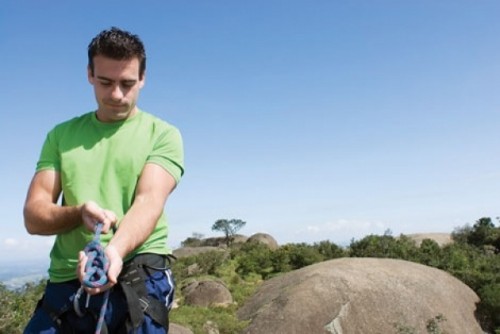Check Your Gear, Save Your Life
Before summer hits, inspect your shoes, bike and climbing rope.
By Wina SturgeonTake that pair of running shoes. They won’t last nearly as long as you think. Joel Pino, a manager at Salt Lake Running Company, says, “Most (athletic) shoes are made out of EVA, a petroleum-based foam. The problem with EVA is it will start to oxidize and dry out, even if shoes aren’t being used. You can buy a pair of shoes and put them in your closet for a year, and you’ll be lucky to get 100 miles out of [them].”
Even brand-new running shoes are limited. “A good pair of running shoes, which costs about $100, will only get you about 300-500 miles. Every time you run, every time your foot strikes the ground, that’s three times the force of your body weight. If the foam is packed down, your body takes that stress—not the shoe—because the worn-out shoe is not absorbing the shock. The result can be shin splints or knee pain,” Pino says.
Worse, the harm from worn-out shoes builds up, causing damage that creates painful conditions later in life. Just because the shoe was expensive doesn’t mean it will last for years.
As for your bike, whether road, mountain or BMX, it needs to be checked after its long winter rest. Unless you’re an expert, have a shop do a tune up. “After a bike sits a while, tires will have lost air, lubrication will have gotten old and dried out, and there may be corrosion,” warns Marc Divall, a mechanic at Contender Bike Shop in Salt Lake. “Tires need to be checked to see that the rubber is still supple and safe. You could have dry rot, where the rubber gets brittle and can blow out when you’re riding. You should have a tire gauge to inflate it to the proper pressure. Too much or too little pressure will cause more frequent flatting.”
Divall recommends making sure the bike is safe to ride, with wheels and handlebar nuts and bolts secured, and the chain cleaned and lubricated. A complete tune up costs about $50, but includes cleaning, brake and derailleur adjustment and wheel truing. Divall says, “If you haven’t ridden your bike for a year or more, it definitely needs a checkup.”
Now for the sport where a gear inspection can save your life: climbing. There have already been some serious accidents along the Wasatch Front this year.
The most important things to check out are the obvious: rope, harness and carabiners. Ryan Barez, an instructor at Rockreation climbing gym, says that visual inspection of a rope is key to making sure it’s free from potentially fatal defects, one of which is a soft core. A rope should be rigid, not floppy. Barez suggests the “pinch test,” where a small section of climbing rope is doubled over to create two parallel strands between your fingers. He says, ”If the rope is strong and rigid enough to be safe, the doubled over part will form a loop. If it just flops over against the other strand, the rope has been stretched out and the core is soft, or (in climber lingo,) ‘compromised.’ Retire that rope and buy a new one.”
Like a helmet, a hard fall on a rope renders it useless. A long fall where the rope saves you from impacting the ground usually stretches out all “give” in the rope, so it needs replacing.
Barez says that a harness, like shoes, doesn’t last as long as many climbers think: “Harnesses need to be retired if any of the major weight holding parts are frayed, or just if the harness is old.” He retires his harnesses every three to five years.
Also, inspect your carabiners. If they’ve had a rope running over them for so long that they’ve become grooved, that can create sharp edges. Barez warns, “You run the risk of cutting your rope on it if you fall on a carabiner with a groove.”
He warns, “If anything is visually compromised, it needs to be retired. Even if you have any doubts, listen to your gut. The general rule is, when you climb, you should do a full visual inspection about every 10 climbs.”
More by Wina Sturgeon
-
Conquer the Superpipe
Some advice to help you take the plunge
- Jan 8, 2013
-
Park City Shortcuts
Bypass the traffic and be on your way
- Dec 24, 2012
-
Ride the Terrain Park
Start learning or polish your skills
- Dec 11, 2012
- More »



